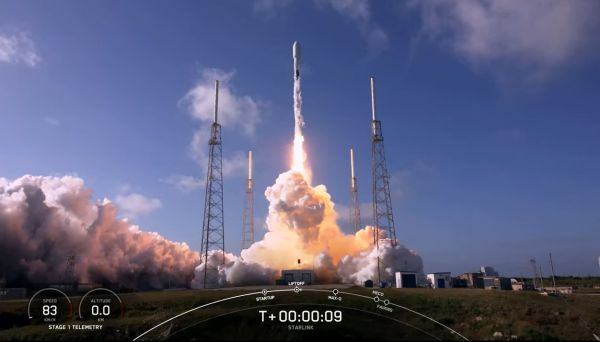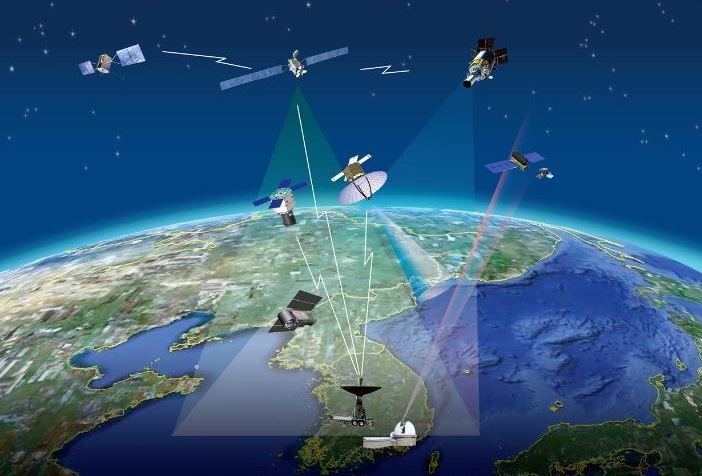Musk’s SpaceX Starshield Business Unit Is Building Spy Satellite Network For U.S. Intelligence Agency; The Race For Spy Satellites Intensifies; Where Does India Stand?
Geopolitical developments are changing fast, and the competition for dominance in space is heating up, particularly between regional powers such as the United States, India and China. Recent reports suggest that Musk's SpaceX, under a veil of secrecy, has undertaken a groundbreaking mission in collaboration with a U.S. intelligence agency. Reports indicate that SpaceX's Starshield business unit is tasked with constructing a constellation of spy satellites under a classified contract worth $1.8 billion with the National Reconnaissance Office (NRO). Meanwhile, back home, China's significant strides in developing a network of 'spy satellites' for reconnaissance and surveillance have spurred India to bolster its own capabilities - Musk and Tata Forge Alliance for India's Inaugural Private-Sector Surveillance Satellite - further spewing competition between New Delhi and Beijing.

In an era where information is power, the race for supremacy has extended far beyond terrestrial boundaries. Countries worldwide are vying to expand their networks of spy satellites, leveraging cutting-edge technology to gain strategic advantage and enhance national security.
Recent revelations have shed light on the secret efforts of nations to strengthen their space-based reconnaissance capabilities. Prominent contenders in this orbital arms race include the United States, China, India, Japan, and North Korea, each striving to bolster their spy satellite networks.
However, it is the United States, spearheaded by innovative ventures like SpaceX, that has taken center stage in pushing the boundaries of satellite surveillance.
Under a veil of secrecy, SpaceX, the brainchild of billionaire entrepreneur Elon Musk, has undertaken a groundbreaking mission in collaboration with a U.S. intelligence agency.
Reports indicate that SpaceX’s Starshield business unit is tasked with constructing a constellation of spy satellites under a classified contract worth $1.8 billion with the National Reconnaissance Office (NRO).
This ambitious endeavour also signifies a deepening partnership between the private sector and national security agencies, hence heralding a new era of space-based reconnaissance capabilities.

SpaceX And Pentagon
The scope of SpaceX’s involvement emphasizes the Pentagon’s aim to bolstering vast, low-Earth orbiting satellite systems aimed at supporting ground forces.
If successful, this program promises to revolutionize the ability of the U.S. government and military to swiftly identify potential targets across the globe, ushering in a new era of surveillance and intelligence gathering.
However, the collaboration between SpaceX and the intelligence community has not been without controversy.
Elon Musk’s controversial relationship with the Biden administration and the controversy surrounding the use of Starlink satellite connectivity during the Ukraine war has raised eyebrows within the corridors of power.
Yet, despite these challenges, the intelligence establishment seems to have trusted SpaceX, perhaps recognizing the company’s technological prowess and pivotal role in advancing national security objectives.
The Spying Clouds
While details surrounding the project remain shrouded in secrecy, it is clear that the new network of satellites will possess unparalleled Earth-imaging capabilities, operating as a formidable swarm in low orbits.
These satellites, equipped with advanced tracking capabilities, will provide real-time intelligence and reconnaissance data to U.S. intelligence and military officials, enhancing situational awareness and decision-making capabilities on a global scale.
The deployment of roughly a dozen prototypes since 2020, alongside SpaceX’s Falcon 9 rockets, indicates the rapid pace of development in this domain.
A database maintained by the U.S. government tracking objects orbiting the Earth has unveiled a series of SpaceX missions that quietly deployed satellites, unrecognized by both the company and government authorities.
These satellites, confirmed by two anonymous sources, are revealed to be prototypes for the secretive Starshield network.
All sources involved have chosen to remain anonymous due to lack of authorization to discuss the U.S. government program.
The Pentagon, already a significant SpaceX client, utilizes the company’s Falcon 9 rockets to launch military payloads into space.
The first prototype satellite for Starshield, launched in 2020, was reportedly part of a distinct contract valued at approximately $200 million. According to one source, this contract played a crucial role in positioning SpaceX for the subsequent $1.8 billion award.
It’s crucial to note that the planned Starshield network operates independently of Starlink, SpaceX’s commercial broadband constellation, which currently boasts around 5,500 satellites in orbit.
While Starlink focuses on providing near-global internet access, Starshield is a classified constellation of spy satellites, representing one of the U.S. government’s most coveted space capabilities.
Its design aims to deliver persistent, pervasive, and rapid coverage of Earth’s activities. Describing the network’s potential reach, one source emphasized, “No one can hide.”
The Starshield initiative reflects the escalating competition between the United States and its adversaries to assert dominance in space, emphasizing the shift towards low-orbiting satellite systems for enhanced military capabilities.
China’s plans to develop its own satellite constellations and the Pentagon’s warnings of space-based weapon threats from Russia show the strategic importance of initiatives like Starshield – designed to be resilient against sophisticated space adversaries, Starshield aims to significantly expand the U.S. government’s remote-sensing capabilities.
The network will consist of large satellites equipped with imaging sensors, supplemented by relay satellites facilitating data transmission using inter-satellite lasers.
The National Reconnaissance Office (NRO), comprising personnel from the U.S. Space Force and CIA, oversees the project and provides classified satellite imagery for various intelligence agencies.
Interestingly, the sensors housed within the spy satellites will be supplied by another company, as revealed by three of the sources.

The Competiton, India VS China
China has made substantial progress in constructing a network of ‘surveillance satellites,’ a term attributed to satellites utilized for reconnaissance and monitoring purposes.
Given the strained relations between both nations, India has enlisted the support of private entities to fabricate military-grade surveillance satellites, with the first installment crafted by Tata Advanced Systems Ltd (TASL) poised for launch in April.
Thus, it marks a critical juncture for India, which is harnessing the capabilities of its private sector to address growing requirements within the space domain.
The same has generated a buzz within Russian telegram news channels, suggesting that India is poised to surpass Russia in terms of satellite launches this year.
Equally significant is India’s emphasis on leveraging space assets for military purposes – in addition to monitoring adversary movements and troop deployments, these satellites will support satellite-linked unmanned aerial vehicles, which the Indian Armed Forces are integrating into their arsenal.
The Indian military has already commenced the integration of Israeli Hermes-900 drones and plans to incorporate the American MQ-9B in the future.

China
However, India’s satellite count pales in comparison to China’s vast fleet.
According to the Military Balance report by the International Institute for Strategic Studies in London, China operated 136 reconnaissance satellites in 2022, a significant increase from 66 in 2019.
Against this backdrop, the impending launch of the first private surveillance satellite represents a noteworthy milestone for India. TASL’s maiden surveillance satellite is en route to Florida, where it is scheduled for deployment aboard a SpaceX rocket in April.
Surveillance satellites monitor a spectrum of activities, including troop movements and missile launches, from an altitude of 500 kilometers. Such intelligence is invaluable for India in monitoring adversary assets during potential conflicts and targeting them if necessary.
India has traditionally relied on the United States for accessing reconnaissance data, necessitating precise coordinates and timings to be provided to foreign vendors for imagery acquisition.
In response to escalating tensions with China, India has augmented its constellation of radar imaging satellites (RISAT), expanding from 12 satellites in 2019 to 16.
RISAT-2, India’s inaugural dedicated reconnaissance satellite, was developed swiftly following the 2008 Mumbai terror attacks. It was utilized for border surveillance, anti-infiltration, and counter-terrorism operations before being decommissioned in October 2022.
RISAT-2B, launched in May 2019, features an indigenous X-Band radar and is capable of capturing high-resolution spot images with a resolution of 0.5 x 0.3 meters. Similarly, RISAT-2BR1, launched in December 2019, boasts a mission life of five years and serves similar purposes with a resolution of 0.35 meters.
Meanwhile, Beijing is bolstering its arsenal of electronic intelligence (ELINT) and signals intelligence (SIGINT) satellites to intercept electronic data.
The expansion of the People’s Liberation Army’s intelligence, surveillance, and reconnaissance satellites poses a significant challenge, particularly in the Indo-Pacific region, as highlighted in a report by the US Defense Department released in October 2023.
India’s foremost intelligence-gathering satellite, EMISAT, has scrutinized the positions of the Chinese People’s Liberation Army (PLA) in occupied Tibet.
Additionally, India possesses an ELINT satellite, launched in 2019, which demonstrated its efficacy by traversing over the PLA positions in Tibet near Arunachal Pradesh.
The RISAT-2BR1 conducted a flyover above the People’s Liberation Army Navy (PLAN) base in Djibouti, situated in the Horn of Africa. Notably, this base serves as the PLAN’s inaugural overseas military installation.
Furthermore, on July 11, 2020, EMISAT traversed near the Pakistan Navy’s Ormara base (Jinnah Naval Base), which features submarine berthing facilities and has purportedly hosted Chinese submarines in recent years.

The Space Age For The Indian Military
The Indian Armed Forces’ aspiration for a dedicated satellite network is materializing.
In 2023, the Ministry of Defence entered into a contract worth Rs. 2963 Crores with New Space India Limited (NSIL), the commercial wing of the Indian Space Research Organisation (ISRO), for the development of the Geostationary Satellite (GSAT)-7B.
This initiative aims to furnish the Indian Army (IA) with an advanced communications satellite dedicated to enhancing intra- and inter-service communication in network-centric warfare.
The Indian Defense Acquisition Council accorded Acceptance of Necessity (AoN) for the GSAT-7B under the Buy Indian (Indigenously Designed, Developed, and Manufactured-IDDM) category in 2022.
The Indian Army conducted an extensive analysis of network-centric warfare and stand-alone cyber, communication, and electronic warfare systems employed in the Russia-Ukraine conflict.
Subsequently, it proposed the establishment of robust and secure satellite communications to connect forces deployed in combat zones with their headquarters located inland.
The heightened tensions with China have catalyzed the Indian Army’s contemplation of such measures.

The Viewpoint
As the world edges closer to an era of pervasive satellite surveillance, the implications of these advancements are deep.
While proponents argue that enhanced reconnaissance capabilities will bolster national security and deter adversaries, skeptics raise concerns about privacy violations and the potential for misuse of power.
Yet, in the quest for dominance among the stars, the stakes have never been higher.
The convergence of cutting-edge technology, geopolitical tensions, and commercial interests has transformed space into an arena of competition as nations race to expand their reach beyond the confines of Earth.




